Bird List
Date: May 10, 2014
Location: Orilla Verde Recreation Area
Weather: Clear, Calm
Early Walk:
Early Walk Bird List
Time: 6:45am-8:45am
Number of Species: 33
Late Walk:
Late Walk Bird List
Time: 9:00am-11:20am
Number of Species: 32
Total Species for both walks: 41
English Name:
Genus species: | Comments | Photos |
| Swans, Geese and Ducks |
Canada Goose
Branta canadensis
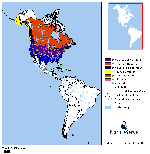
Enlarge Map
External Sites:
Cornell
USGS
Image Search | Seen only on the Rio Grande.
Note white mark on Cheek.
Larger than local Ducks.
Number of Individuals Observed:3 | 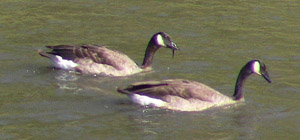 |
Mallard
Anas platyrhynchos
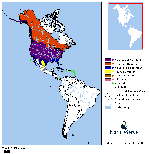
Enlarge Map
External Sites:
Cornell
USGS
Image Search | Note white horizontal mark at rear on both Female (above)
and
Male (below).
Male plumage distinctive.
Number of Individuals Observed:7 | 
Rinconada
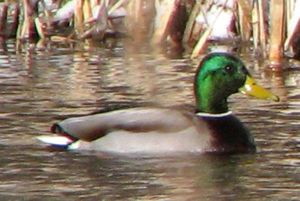
Rinconada |
| Diurnal Raptors: Vultures, Eagles, Hawks and Falcons |
Golden Eagle
Aquila chrysaetos
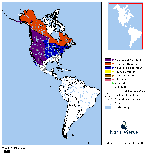
Enlarge Map
External Sites:
Cornell
USGS
Image Search |
Number of Individuals Observed:2 | 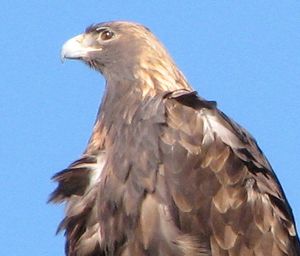
Maxwell, NM, December 18, 2007
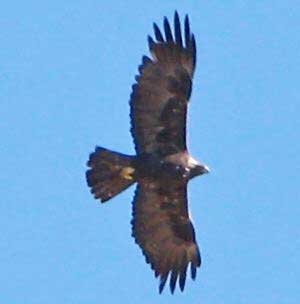
Orilla Verde, October 27, 2008 |
| Smaller Wading Birds |
Spotted Sandpiper
Actitis macularius
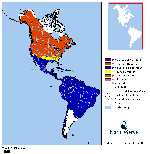
Enlarge Map
External Sites:
Cornell
USGS
Image Search |
Number of Individuals Observed:2 | 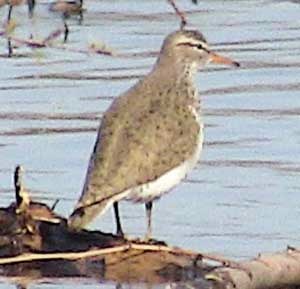 |
| Pigeons and Doves |
Eurasian Collared-Dove
Streptopelia decaocto
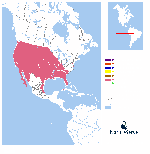
Enlarge Map
External Sites:
Cornell
USGS
Image Search |
Number of Individuals Observed:1 | 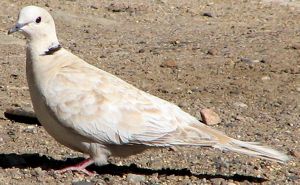 |
Mourning Dove
Zenaida macroura
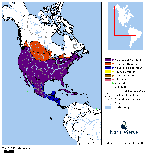
Enlarge Map
External Sites:
Cornell
USGS
Image Search | Generally seen flying in small groups (2-4 individuals).
Note long, pointed tail which shows white edges when landing.
Call is a soft, slow "who-AH, who, who, who" heard during the day. (Commonly mistaken for an owl. Note: Owls usually do not call during daylight hours)
Number of Individuals Observed:2 | 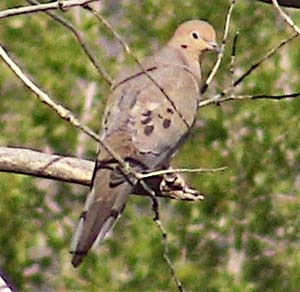
El Bosque
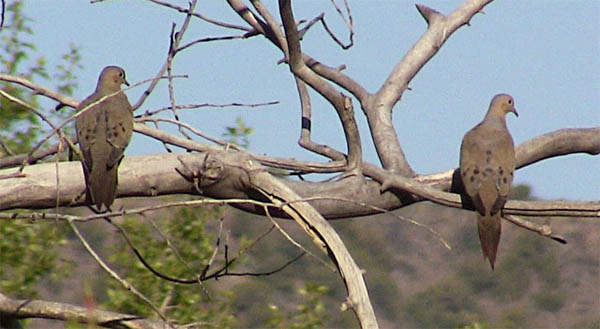
El Bosque |
| Hummingbirds |
Broad-tailed Hummingbird
Selasphorus platycercus
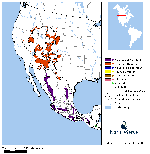
Enlarge Map
External Sites:
Cornell
USGS
Image Search | Begins arriving in early April.
One of only two hummingbirds that regularly breed here.
In the right light, male's throat is red.
Often appears plumper and rounder than the Black-chinned Hummingbird.
Male's wing make a distinctive, loud buzz in flight.
Male is pictured. Female has plain throat.
Number of Individuals Observed:2 | 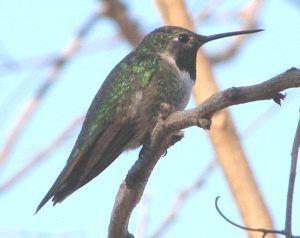
Dixon
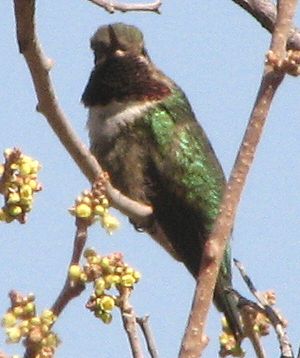
Dixon
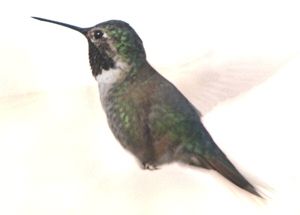
Dixon |
| Kingfishers |
Belted Kingfisher
Ceryle alcyon
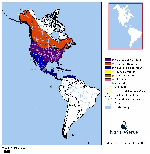
Enlarge Map
External Sites:
Cornell
USGS
Image Search | Perches on trees or wires near water. Hovers over water before diving for fish or crustaceans.
Gives a distinctive long, loud rattle in flight.
Male has gray breast band. Female has additional rufous band below.
Number of Individuals Observed:1 | 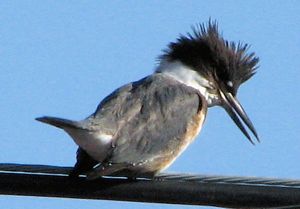
El Bosque
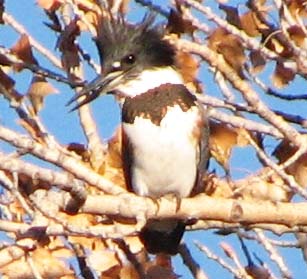
El Bosque |
| Tyrant Flycatchers |
Gray Flycatcher
Empidonax wrightii
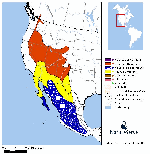
Enlarge Map
External Sites:
Cornell
USGS
Image Search |
Number of Individuals Observed:1 | Click for Photos |
Say's Phoebe
Sayornis saya
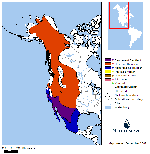
Enlarge Map
External Sites:
Cornell
USGS
Image Search | A few individuals over-winter in Velarde. In the rest of the Embudo area begins arriving in early March.
Usually seen on posts or single stalk plants in agricutural areas "hawking" insects.
It's call is a slow, plaintive, downward slurred "pee-ee". At close range, may hear "pit,pee-ee".
Distinctive peach-colored belly.
This species regularly builds nests under people's portales.
Number of Individuals Observed:1 | 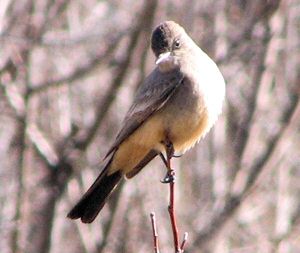
Rinconada |
Ash-throated Flycatcher
Myiarchus cinerascens
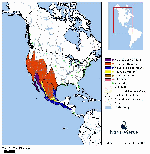
Enlarge Map
External Sites:
Cornell
USGS
Image Search | Begins arriving in mid-April.
Number of Individuals Observed:1 | 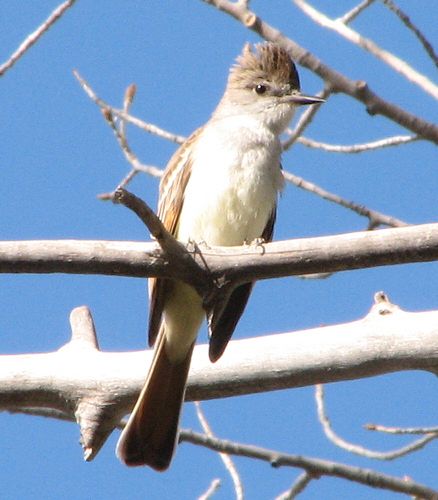
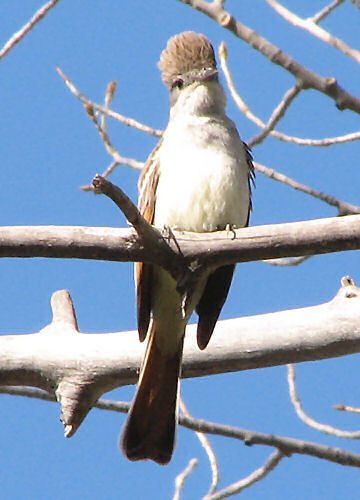 |
| Jays, Crows and their Allies |
Western Scrub-Jay
Aphelocoma californica
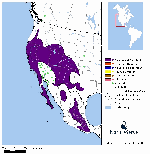
Enlarge Map
External Sites:
Cornell
USGS
Image Search | Common in all area habitats.
Note white throat and faint white eyebrow.
Also brownish-gray back.
Distinguished from the Pinyon Jay by longer tail and solitary behavior.
Number of Individuals Observed:1 | 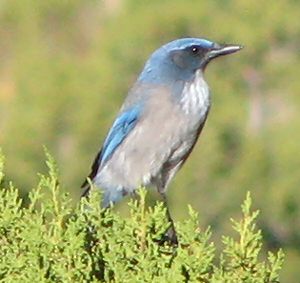
Arroyo la Mina
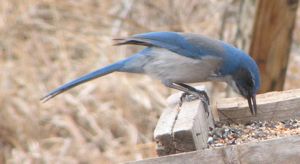
Cañoncito |
Black-billed Magpie
Pica hudsonia
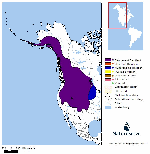
Enlarge Map
External Sites:
Cornell
USGS
Image Search | Unmistakable large black and white bird with very long tail.
Number of Individuals Observed:2 | 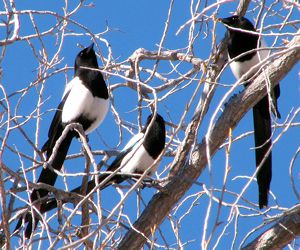
El Bosque |
| Swallows |
N. Rough-winged Swallow
Stelgidopteryx serripennis
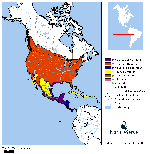
Enlarge Map
External Sites:
Cornell
USGS
Image Search | Begins arriving in last half of March.
Number of Individuals Observed:3 | 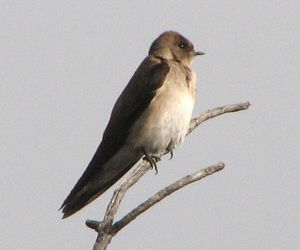
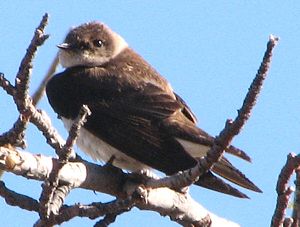 |
| Chickadees and their Allies |
Bushtit
Psaltriparus minimus
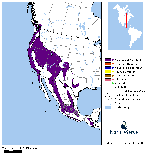
Enlarge Map
External Sites:
Cornell
USGS
Image Search | Tiny (~4in) plain gray bird.
Usually travels in groups of 10-20 individuals, constantly moving from bush to bush feeding.
Flocking birds constantly make varied twittering sounds.
Number of Individuals Observed:3 | 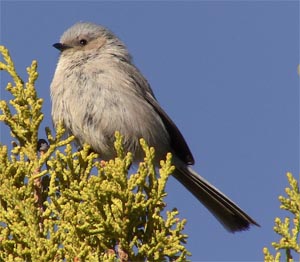
Camino Lejo, Santa Fe |
| Wrens |
Rock Wren
Salpinctes obsoletus
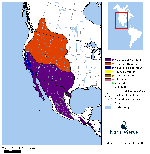
Enlarge Map
External Sites:
Cornell
USGS
Image Search |
Number of Individuals Observed:2 | 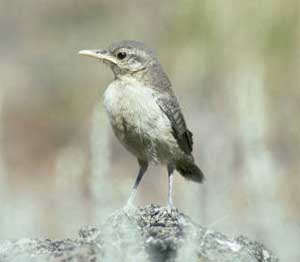
Photo: Dave Menke USFWS California |
| Kinglets and Gnatcatchers |
Blue-gray Gnatcatcher
Polioptila caerulea

Enlarge Map
External Sites:
Cornell
USGS
Image Search |
Number of Individuals Observed:2 | Click for Photos |
| Thrushes and their Allies |
Western Bluebird
Sialia mexicana
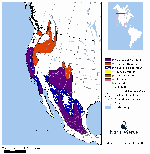
Enlarge Map
External Sites:
Cornell
USGS
Image Search | Male (top photo) has blue head and red breast.
During breeding season, colors more intense than shown here.
Female (lower photo) has blue in wings, but appears gray from front with a light buffy breast.
Note white eye-ring.
Number of Individuals Observed:2 | 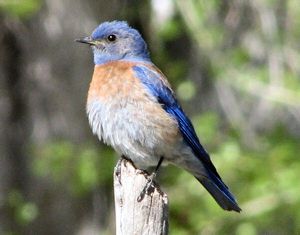
El Bosque
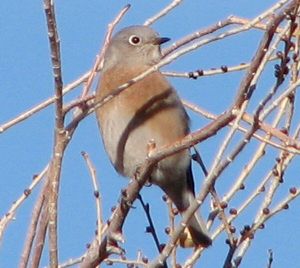
El Bosque |
American Robin
Turdus migratorius
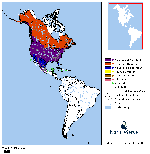
Enlarge Map
External Sites:
Cornell
USGS
Image Search | Best known American Bird.
Note reddish breast, light colored bill and large white split eye-ring.
Number of Individuals Observed:3 | 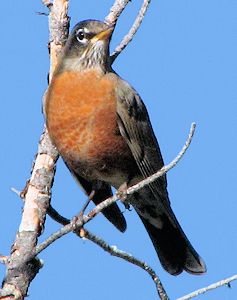
El Bosque |
| Waxwings |
Cedar Waxwing
Bombycilla cedrorum
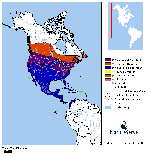
Enlarge Map
External Sites:
Cornell
USGS
Image Search |
Number of Individuals Observed:15 | 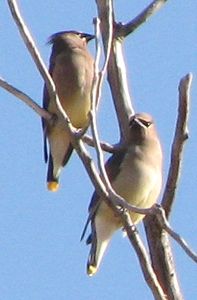
Río Ojo Sarco
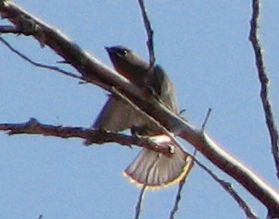
Río Ojo Sarco |
| Wood-Warblers |
Virginia’s Warbler
Vermivora virginiae
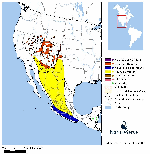
Enlarge Map
External Sites:
Cornell
USGS
Image Search |
Number of Individuals Observed:2 | 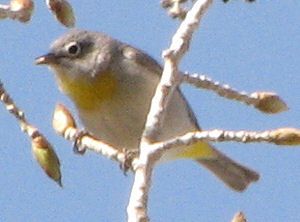
Ojo Sarco
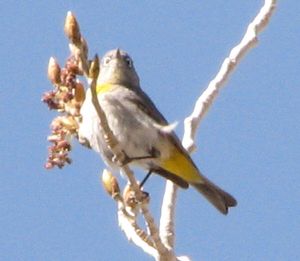
Ojo Sarco |
Yellow Warbler
Dendroica petechia
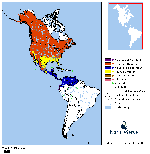
Enlarge Map
External Sites:
Cornell
USGS
Image Search | Begins arriving late-April.
Number of Individuals Observed:2 | 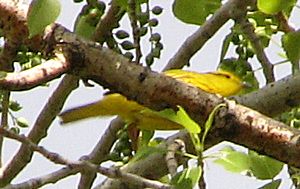
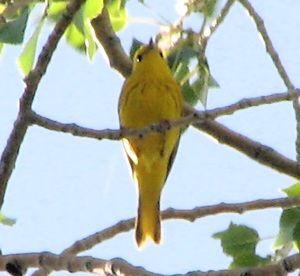
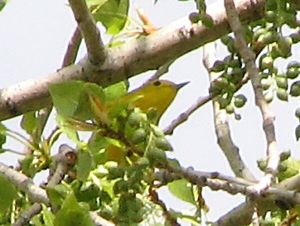 |
Yellow-rumped Warbler
Dendroica coronata
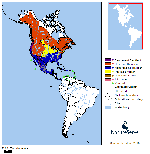
Enlarge Map
External Sites:
Cornell
USGS
Image Search | Many individuals pass through this area during the spring and fall migrations. A few stay over the winter, primarily in the Velarde area.
The first two pictures show breeding plumage.
The last shows typical winter plumage.
Number of Individuals Observed:9 | 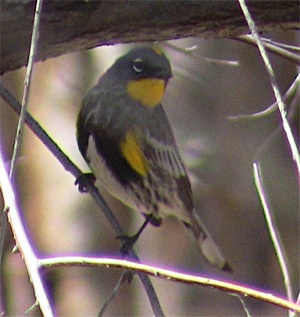
La Junta, April 28, 2013
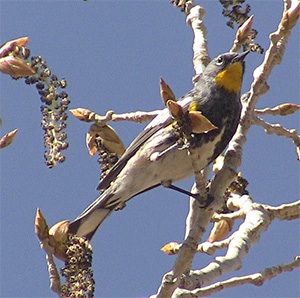
La Junta, April 28, 2013
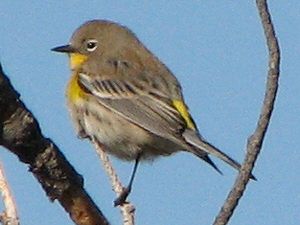
Apodaca |
Yellow-breasted Chat
Icteria virens
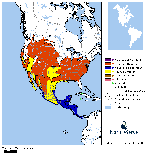
Enlarge Map
External Sites:
Cornell
USGS
Image Search | Begins arriving late-April.
Number of Individuals Observed:2 | 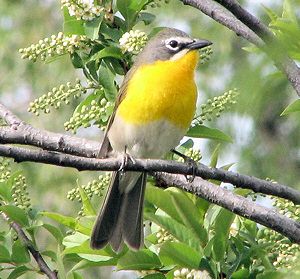
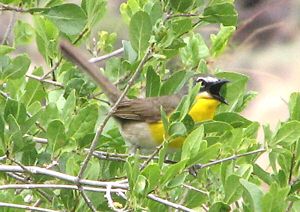 |
| Tanagers |
Western Tanager
Piranga ludoviciana
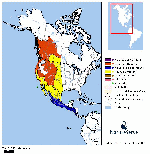
Enlarge Map
External Sites:
Cornell
USGS
Image Search |
Number of Individuals Observed:3 | 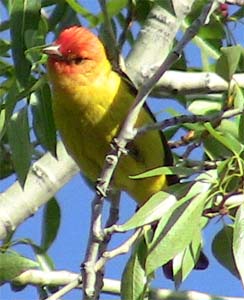
Dixon
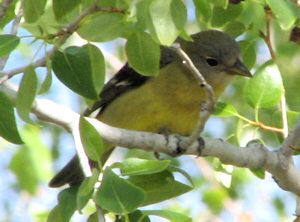
Dixon
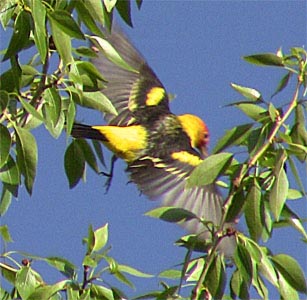
Dixon |
| Towhees |
Spotted Towhee
Pipilo maculatus
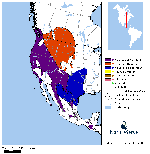
Enlarge Map
External Sites:
Cornell
USGS
Image Search | One is seldom far from a Spotted Towhee. But though they are nearby, they are usually hidden away under trees and shrubs where they toss leaves with their feet looking for insects to eat.
Occasionally you will see one at the edge of the road or briefly flying from one shrub to the next.
However, they regularly produce a contact call, a low growl.
Hear Contact Call
If you listen for that call and follow it, may be rewarded with a view of this lovely bird with a red eye.
Note white breast with rufous (reddish) flanks.
Lower Photo shows bird in its preferred habitat.
Number of Individuals Observed:2 | 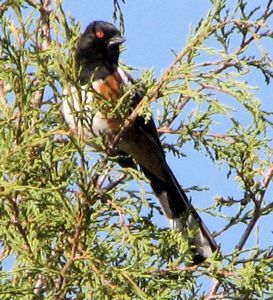
Arroyo la Mina
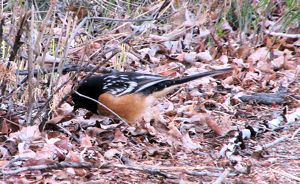
El Bosque Enlarge |
| Grosbeaks |
Black-headed Grosbeak
Pheucticus melanocephalus
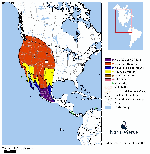
Enlarge Map
External Sites:
Cornell
USGS
Image Search | Begins arriving at end of April.
Number of Individuals Observed:3 | 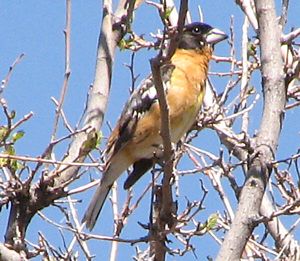
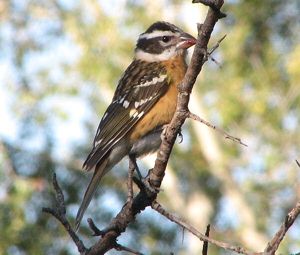 |
| Icterids: Blackbirds, Orioles and their Allies |
Red-winged Blackbird
Agelaius phoeniceus
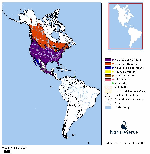
Enlarge Map
External Sites:
Cornell
USGS
Image Search | Female (Upper Picture) has brown streaking all over.
Male (Lower Picture) is black with red patches on shoulders. Outside of breeding times, the red may be hidden.
Both sexes have medium length, very pointed bill.
Number of Individuals Observed:4 | 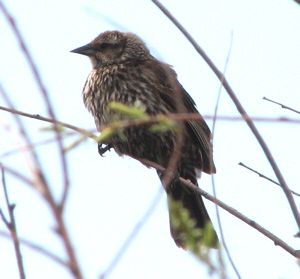
Baca Park, Taos
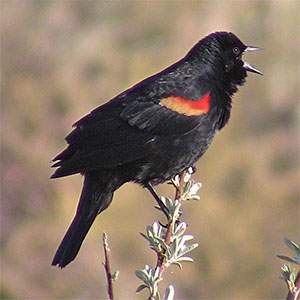
Rinconada Enlarge |
Brewer’s Blackbird
Euphagus cyanocephalus
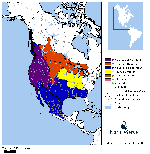
Enlarge Map
External Sites:
Cornell
USGS
Image Search |
Number of Individuals Observed:6 | Click for Photos |
Great-tailed Grackle
Quiscalus mexicanus
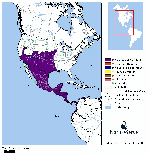
Enlarge Map
External Sites:
Cornell
USGS
Image Search |
Number of Individuals Observed:4 | Click for Photos |
Brown-headed Cowbird
Molothrus ater
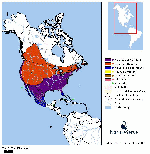
Enlarge Map
External Sites:
Cornell
USGS
Image Search |
Number of Individuals Observed:3 | 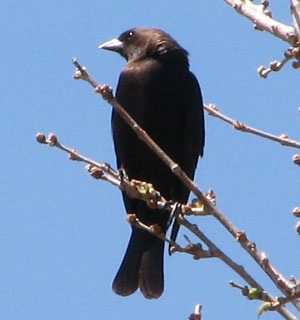
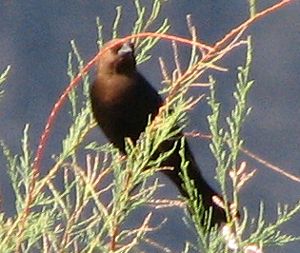 |
Bullock's Oriole
Icterus bullockii
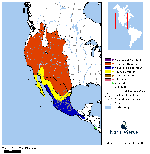
Enlarge Map
External Sites:
Cornell
USGS
Image Search | Begins arriving at end of April.
Number of Individuals Observed:2 | 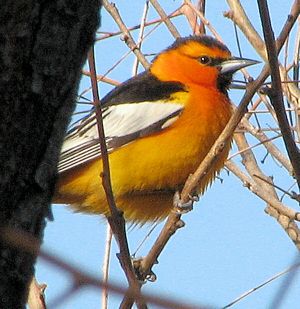
El Bosque
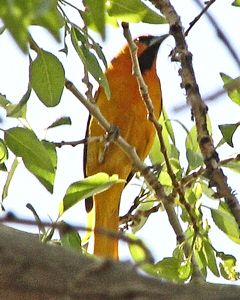
El Bosque |
| Finches and Old World Sparrows |
House Finch
Carpodacus mexicanus
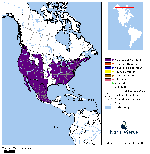
Enlarge Map
External Sites:
Cornell
USGS
Image Search | Often seen at feeders, this species is common in all habitats, especially agricultural areas.
Male (upper picture) is easily identified by red plumage on head, throat, breast and rump.
Female (lower photo) does not have red.
Both sexes have streaking on breast, belly and flanks.
Number of Individuals Observed:4 | 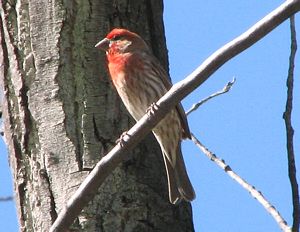
Arroyo La Mina
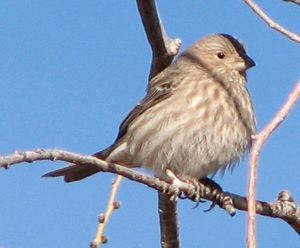
Arroyo La Mina |
English Name:
Genus species: | Comments | Photos |
| Swans, Geese and Ducks |
Canada Goose
Branta canadensis

Enlarge Map
External Sites:
Cornell
USGS
Image Search | Seen only on the Rio Grande.
Note white mark on Cheek.
Larger than local Ducks.
Number of Individuals Observed:2 |  |
Mallard
Anas platyrhynchos

Enlarge Map
External Sites:
Cornell
USGS
Image Search | Note white horizontal mark at rear on both Female (above)
and
Male (below).
Male plumage distinctive.
Number of Individuals Observed:4 | 
Rinconada

Rinconada |
Common Merganser
Mergus merganser
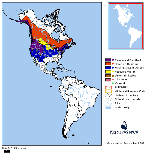
Enlarge Map
External Sites:
Cornell
USGS
Image Search | Distinctive bill shape and color.
Male has dark head.
Female reddish-brown head.
Number of Individuals Observed:1 | 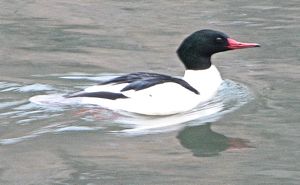
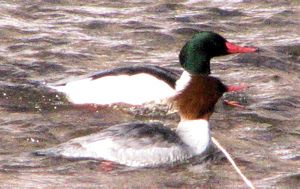 |
| Diurnal Raptors: Vultures, Eagles, Hawks and Falcons |
Cooper’s Hawk
Accipiter cooperii

Enlarge Map
External Sites:
Cornell
USGS
Image Search | Adult is pictured. Note the horizontal barring on the breast and belly.
Number of Individuals Observed:1 | 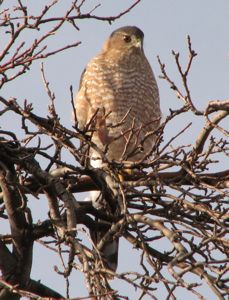
El Bosque |
Red-tailed Hawk
Buteo jamaicensis
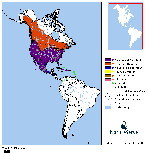
Enlarge Map
External Sites:
Cornell
USGS
Image Search | Often easily identified by visible red tail.
If tail is not visible, other field marks can be used:
From below in flight, the dark front edges of the wings next to the body and the dark "commas" at the wrist are unique among local hawks.
When perched, the dark belly band against the white front is diagnostic.
Juveniles (lowest photo) do not yet have a red tail.
Number of Individuals Observed:3 | 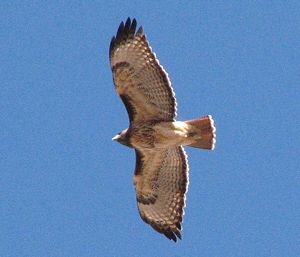
El Bosque
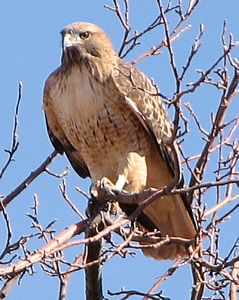
El Bosque
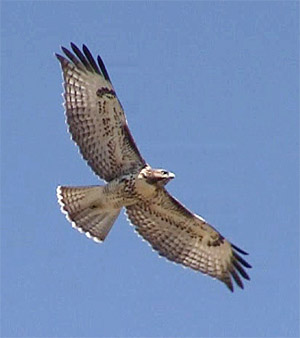
Camino Lejo, Santa Fe |
Golden Eagle
Aquila chrysaetos

Enlarge Map
External Sites:
Cornell
USGS
Image Search |
Number of Individuals Observed:2 | 
Maxwell, NM, December 18, 2007

Orilla Verde, October 27, 2008 |
| Pigeons and Doves |
Mourning Dove
Zenaida macroura

Enlarge Map
External Sites:
Cornell
USGS
Image Search | Generally seen flying in small groups (2-4 individuals).
Note long, pointed tail which shows white edges when landing.
Call is a soft, slow "who-AH, who, who, who" heard during the day. (Commonly mistaken for an owl. Note: Owls usually do not call during daylight hours)
Number of Individuals Observed:1 | 
El Bosque

El Bosque |
| Hummingbirds |
Broad-tailed Hummingbird
Selasphorus platycercus

Enlarge Map
External Sites:
Cornell
USGS
Image Search | Begins arriving in early April.
One of only two hummingbirds that regularly breed here.
In the right light, male's throat is red.
Often appears plumper and rounder than the Black-chinned Hummingbird.
Male's wing make a distinctive, loud buzz in flight.
Male is pictured. Female has plain throat.
Number of Individuals Observed:1 | 
Dixon

Dixon

Dixon |
| Kingfishers |
Belted Kingfisher
Ceryle alcyon

Enlarge Map
External Sites:
Cornell
USGS
Image Search | Perches on trees or wires near water. Hovers over water before diving for fish or crustaceans.
Gives a distinctive long, loud rattle in flight.
Male has gray breast band. Female has additional rufous band below.
Number of Individuals Observed:1 | 
El Bosque

El Bosque |
| Tyrant Flycatchers |
Say's Phoebe
Sayornis saya

Enlarge Map
External Sites:
Cornell
USGS
Image Search | A few individuals over-winter in Velarde. In the rest of the Embudo area begins arriving in early March.
Usually seen on posts or single stalk plants in agricutural areas "hawking" insects.
It's call is a slow, plaintive, downward slurred "pee-ee". At close range, may hear "pit,pee-ee".
Distinctive peach-colored belly.
This species regularly builds nests under people's portales.
Number of Individuals Observed:1 | 
Rinconada |
Ash-throated Flycatcher
Myiarchus cinerascens

Enlarge Map
External Sites:
Cornell
USGS
Image Search | Begins arriving in mid-April.
Number of Individuals Observed:1 | 
 |
Cassin's Kingbird
Tyrannus vociferans
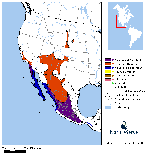
Enlarge Map
External Sites:
Cornell
USGS
Image Search | A migrant, this species winters in both mainland Mexico and Baja California.
Individuals begin arriving in this area by mid-April. Some pass through to places further north, but many breed here during the summer. They begin moving south to their wintering grounds in early Fall.
This species is very noisy making a variety of sounds including its signature, exuberant: "Chi-beer!"
Number of Individuals Observed:1 | 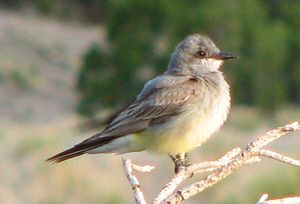
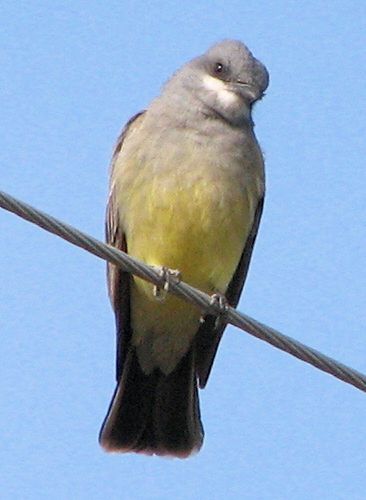 |
| Jays, Crows and their Allies |
Black-billed Magpie
Pica hudsonia

Enlarge Map
External Sites:
Cornell
USGS
Image Search | Unmistakable large black and white bird with very long tail.
Number of Individuals Observed:1 | 
El Bosque |
Common Raven
Corvus corax
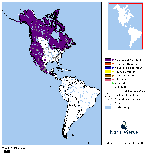
Enlarge Map
External Sites:
Cornell
USGS
Image Search | At times difficult to distinguish from American Crow.
By sound, a throaty chortle or shout.
In flight, the tail often appears wedge shaped.
Ravens are often solitary, but sometimes appear with a few other individuals.
Often soars like a hawk. Crows do not.
Bill is thick and heavy. The throat is shaggy compared to the Crow.
Breeding pairs perform synchronized flight high overhead.
Number of Individuals Observed:2 | 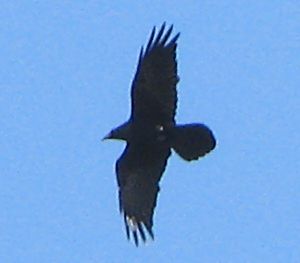
El Bosque
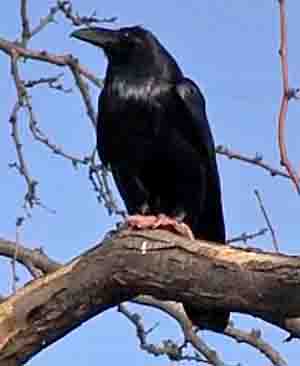
Camino de los Marquez, Santa Fe |
| Swallows |
Violet-green Swallow
Tachycineta thalassina
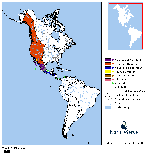
Enlarge Map
External Sites:
Cornell
USGS
Image Search | Very common during spring migration.
All white below, with white wrapping up the sides of the rump as shown in the upper individual in the lower photo.
In right light, the back reveals brilliant violet and green colors.
Number of Individuals Observed:1 | 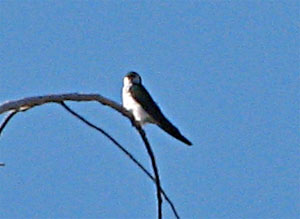
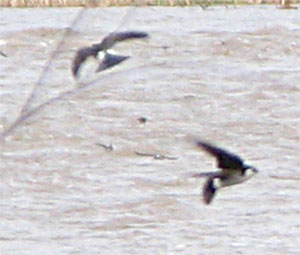 |
N. Rough-winged Swallow
Stelgidopteryx serripennis

Enlarge Map
External Sites:
Cornell
USGS
Image Search | Begins arriving in last half of March.
Number of Individuals Observed:1 | 
 |
| Thrushes and their Allies |
Western Bluebird
Sialia mexicana

Enlarge Map
External Sites:
Cornell
USGS
Image Search | Male (top photo) has blue head and red breast.
During breeding season, colors more intense than shown here.
Female (lower photo) has blue in wings, but appears gray from front with a light buffy breast.
Note white eye-ring.
Number of Individuals Observed:1 | 
El Bosque

El Bosque |
American Robin
Turdus migratorius

Enlarge Map
External Sites:
Cornell
USGS
Image Search | Best known American Bird.
Note reddish breast, light colored bill and large white split eye-ring.
Number of Individuals Observed:2 | 
El Bosque |
| Starlings and Mynas |
European Starling
Sturnus vulgaris
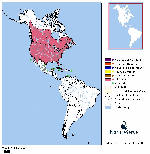
Enlarge Map
External Sites:
Cornell
USGS
Image Search | Usually appears black.
Often seen flying in large flocks. Flocks move very quickly, changing directions often.
Very short tail is distinctive among "blackbirds".
Note bright yellow bill.
Number of Individuals Observed:1 | 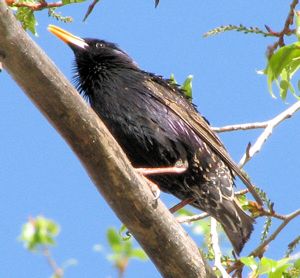
El Bosque Enlarge |
| Wood-Warblers |
Yellow Warbler
Dendroica petechia

Enlarge Map
External Sites:
Cornell
USGS
Image Search | Begins arriving late-April.
Number of Individuals Observed:1 | 

 |
Yellow-rumped Warbler
Dendroica coronata

Enlarge Map
External Sites:
Cornell
USGS
Image Search | Many individuals pass through this area during the spring and fall migrations. A few stay over the winter, primarily in the Velarde area.
The first two pictures show breeding plumage.
The last shows typical winter plumage.
Number of Individuals Observed:6 | 
La Junta, April 28, 2013

La Junta, April 28, 2013

Apodaca |
Yellow-breasted Chat
Icteria virens

Enlarge Map
External Sites:
Cornell
USGS
Image Search | Begins arriving late-April.
Number of Individuals Observed:1 | 
 |
| Tanagers |
Western Tanager
Piranga ludoviciana

Enlarge Map
External Sites:
Cornell
USGS
Image Search |
Number of Individuals Observed:2 | 
Dixon

Dixon

Dixon |
| Towhees |
Spotted Towhee
Pipilo maculatus

Enlarge Map
External Sites:
Cornell
USGS
Image Search | One is seldom far from a Spotted Towhee. But though they are nearby, they are usually hidden away under trees and shrubs where they toss leaves with their feet looking for insects to eat.
Occasionally you will see one at the edge of the road or briefly flying from one shrub to the next.
However, they regularly produce a contact call, a low growl.
Hear Contact Call
If you listen for that call and follow it, may be rewarded with a view of this lovely bird with a red eye.
Note white breast with rufous (reddish) flanks.
Lower Photo shows bird in its preferred habitat.
Number of Individuals Observed:2 | 
Arroyo la Mina

El Bosque Enlarge |
| Grosbeaks |
Black-headed Grosbeak
Pheucticus melanocephalus

Enlarge Map
External Sites:
Cornell
USGS
Image Search | Begins arriving at end of April.
Number of Individuals Observed:1 | 
 |
| Icterids: Blackbirds, Orioles and their Allies |
Red-winged Blackbird
Agelaius phoeniceus

Enlarge Map
External Sites:
Cornell
USGS
Image Search | Female (Upper Picture) has brown streaking all over.
Male (Lower Picture) is black with red patches on shoulders. Outside of breeding times, the red may be hidden.
Both sexes have medium length, very pointed bill.
Number of Individuals Observed:5 | 
Baca Park, Taos

Rinconada Enlarge |
Brewer’s Blackbird
Euphagus cyanocephalus

Enlarge Map
External Sites:
Cornell
USGS
Image Search |
Number of Individuals Observed:4 | Click for Photos |
Great-tailed Grackle
Quiscalus mexicanus

Enlarge Map
External Sites:
Cornell
USGS
Image Search |
Number of Individuals Observed:3 | Click for Photos |
Brown-headed Cowbird
Molothrus ater

Enlarge Map
External Sites:
Cornell
USGS
Image Search |
Number of Individuals Observed:2 | 
 |
Bullock's Oriole
Icterus bullockii

Enlarge Map
External Sites:
Cornell
USGS
Image Search | Begins arriving at end of April.
Number of Individuals Observed:1 | 
El Bosque

El Bosque |
| Finches and Old World Sparrows |
House Finch
Carpodacus mexicanus

Enlarge Map
External Sites:
Cornell
USGS
Image Search | Often seen at feeders, this species is common in all habitats, especially agricultural areas.
Male (upper picture) is easily identified by red plumage on head, throat, breast and rump.
Female (lower photo) does not have red.
Both sexes have streaking on breast, belly and flanks.
Number of Individuals Observed:2 | 
Arroyo La Mina

Arroyo La Mina |
Evening Grosbeak
Coccothraustes vespertinus
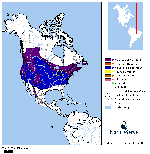
Enlarge Map
External Sites:
Cornell
USGS
Image Search |
Number of Individuals Observed:7 | 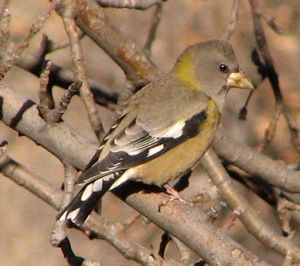
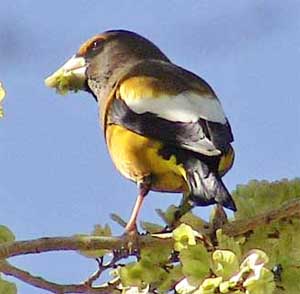 |














































































































